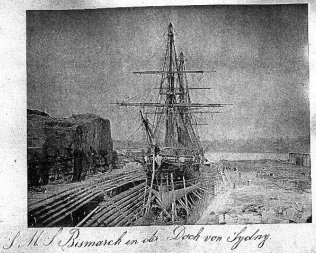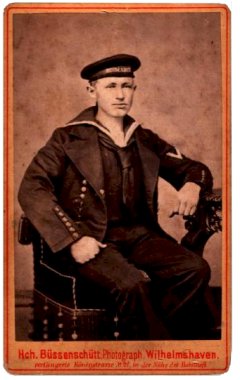![]()
Deserters from German Warships in Australian Ports
Reports of ship desertions were printed in the New South Wales Government Gazette
from 1852 until early in 1862, when this task was taken over by the New South
Wales Police Gazette. Between 1852 and 1900, according to nationality, German
deserters made up the fourth-highest number of deserters in the port of Sydney,
after Englishmen, Irishmen and Scots. A reward was offered by some ships for
the capture and return of their sailors.
German warships that were affected by desertion in Australian ports in the late
19th century include: SMS Albatros (during a Sydney stop in 1884), SMS Alexandrine
(1889), SMS Ariadne (1878), SMS Augusta (1877), SMS Bismarck
(1879, 1880 & 1887), SMS Bussard (1891, 1892, 1895), SMS Falke (1894, 1896,
1897), SMS Gneisenau (1885), SMS Hyane (1885), SMS Leipzig (1890), SMS Marie
(1885), SMS Möwe (1882, 1895, 1899), SMS Nautilus (1879), SMS Olga (1889), SMS
Sophie (1887 & 1890), SMS Sperber (1891, 1892, 1893).
Warships of the Austro-Hungarian Empire: Heligoland (1879), Fasana (1894), Albatross
(1896).
Sample notices of desertion from ships:
| From the Austrian Warship "Fasana", Sydney, on the 8th May, 1894:- | |
| Johann Seliskar | 23 years of age, about 5ft 6in. high, blonde hair, brown eyes, chin and face oval; speaks, writes, and reads German and Slavonian. |
| Friedrich Engelhardt | 20 years of age, about 5ft 8in. high, dark-brown hair, grey eyes, oval chin, long face, teeth defective; speaks writes and reads German and a little English. |
| Deserters wore blue shirt, trousers, and cap, and laced shoes. A reward of £3 each will be paid on apprehension of the abovenamed deserters by the Imperial and Royal Austro-Hungarian Consulate. | |
(A notice dated 16th May 1894 reported that the above men had been arrested by Picton Police and remanded to Sydney. They were discharged by the Water Police Bench, as the ship had gone to sea.)
A considerable number deserted from the German warship SMS Leipzig, including the three named in the following notice from 15th October 1890:
| Wilhelm Martens | 20 years of age, 5ft 9in. high, dark hair, brown eyes, no beard; speaks German and English. £5 reward. |
| Karl Meyer | 22 years of age, 5ft 4in. high, dark hair, blue eyes, small moustache; speaks German only. £5 reward. |
| Richard Wagner | 23 years of age, 5ft 8in. high, black curly hair, brown eyes, no beard; speaks German only. £5 reward. |
From SMS Sperber:
| Ernst Friedrich Vogel | From the German warship "Sperber", Sydney, on the 31st March, 1892. Born at Hamburg, district Saalfeldt, Germany, 22-and-a-half years of age, 5ft 8in. high, strong build, fair hair, blue eyes, oval face; speaks German only; tattooed star with crown on chest, figure of a sailor and bangle on wrist. £5 reward. |
| Emil Georg Max Heim | From the German warship "Sperber", Sydney, on the 20th April, 1892. Assistant sailmaker, born at Stettin, Germany, 26 years of age, 5ft 8in. high, dark blonde hair, blue eyes, oval face; tattooed on left lower arm, anchor on back of hand, speaks German and English. £5 reward. |
Source: J. Melton. 1986. Ships' Deserters 1852-1900. Library of Australian History, Sydney.
S.M.S.
Bismarck
On the 26th January 1880 S.M.S. Bismarck left Apia in German Samoa to return
home to Germany. After putting in at the port of Levkuka in Fiji a heavy storm
caused so much damage to the Bismarck that she had to make an unscheduled trip
to Sydney for repairs. This meant that the ship was able to represent Germany
at Sydney's World Exhibition and the crew were
able to visit the city.
This photo of S.M.S. Bismarck in dry-dock at Sydney was taken by the crewman Claus Franzen.

"SMS Bismarck in der Dock von Sydney"
The following information about Claus Franzen and the portrait were kindly provided by his grandson Bernd in Germany (portrait taken in a photographer's studio in the naval base of Wilhelmshaven):
 |
"My grandfather Claus Franzen was born on 4th February 1857 in Jerrishoe near Flensburg, the son of the farmer Hans Christian Franzen. Claus Franzen no doubt had little interest in farming, for he was confirmed early, in order to sign on as a crew member of a Dutch ship that lay at anchor in Flensburg harbour. For the next five years he sailed on merchant ships. He never reported anything about his experiences on these voyages. Then he joined the Imperial Navy and travelled on the well-known voyage of the frigate Bismarck to the World Exhibition in Australia and to the South Seas, including Samoa. He spoke a lot about this voyage because the countryside, especially the lush vegetation, fascinated him. However, he also talked about seaquakes and the stormy journey around Cape Horn. After the Bismarck's return to Germany he went back home and began working for the post office. There he met his wife Sophie, nee Asmussen, and moved to Süderschmedeby. He died there in 1947 at the old age of 90." |
| Top | Back
| Chronology | Issues
| Students | Site Map |
auf Deutsch |
| Primary Sources (in German) | Bibliography
| Search |
German Australia © D. Nutting 2001